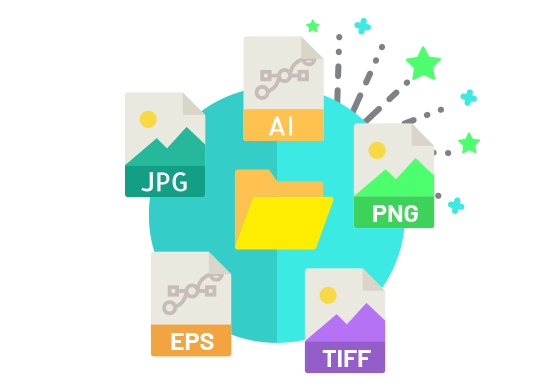Understand (finally!) the different types of graphic files
May 08 2018 / 2 min

Unless you have a background in graphic design, the difference between different file formats may seem obscure! Why one rather than the other? Does it matter? (spoiler alert: yes, it does)
The many formats that exist each have their characteristics and strengths. Some can only be used by specific software, while others are more flexible in handling.
There are two large families:
- Raster files. They are constructed as a pixel canvas (or dot matrix) and have a defined resolution — the larger and more precise the image, the heavier the file.
- Vector files. They are encoded with graphic elements such as lines and curves. These images can be infinitely enlarged without losing quality because the final rendering is mathematically generated from the shapes.
Here is an overview of the most common file types:
- JPEG or JPG. It is one of the most used online formats for pictures and images. It can be edited easily in several software programs. Thanks to its compression capability, it is very convenient for digital advertising.
- GIFs. This file type offers exciting capabilities: it allows you to manage animated images and transparency (very practical!) and provides excellent compression capacity. It is, however, not a suitable format for printing, as the colour palette is limited.
- PNG. This format represents the evolution of the GIF. It allows transparency while offering many more colours (millions!). Perfect for web and illustrations; however, not recommended for photos and print.
- TIFF or TIF. This type of file is suitable for photos with high resolution. It allows a very high image quality but allows heavy files to navigate.
- RAW. If you want to make precise adjustments to a photo, you need a “RAW” file. With this format, you work with the raw image data. Note that several extensions exist; each camera company has produced its own (ex: CRW by Canon).
- PSD. This is PhotoShop’s native format. It is a very flexible format from which other types of files can be exported. It allows you to work in superimposed layers (known as “layers”) and even insert vector images.
- PDF. It is a well-known format with the advantage of being reasonably versatile: it works on multiple platforms and in many different environments. For the web or print, it is almost a universal standard.
- EPS. Typically used for logos, this type of vector file is perfect for ensuring the best resolution, regardless of the size of the final image.
- AI. The native format of the Illustrator software allows to create and edit vector designs, which can then be exported in other formats, depending on the use.
- SVG. Suitable for “Retina” type screens, this format offers high resolution in tiny files. Its content being visible from web browsers is a handy digital media format.

Now that you’ve demystified graphic file types check out our article on web design jargon!
You may also like

Bill C-59 and B2B Marketing: What to Expect
Trust has become one of the most valuable currencies in B2B marketing. It influences buying decisions, customer loy[...]
Branding
Sep 8, 2025
/3 min

When B2B Leaders Unknowingly Hold Back Marketing
Let’s talk about Julie (not her real name). As a marketing manager in a manufacturing company, she was doing it all[...]
Strategy
Aug 25, 2025
/3 min

Maximizing the ROI of Your Trade Shows
What if every dollar you invested in a trade show brought you back four… or even five? Trade show season is approac[...]
Branding
Aug 11, 2025
/4 min
